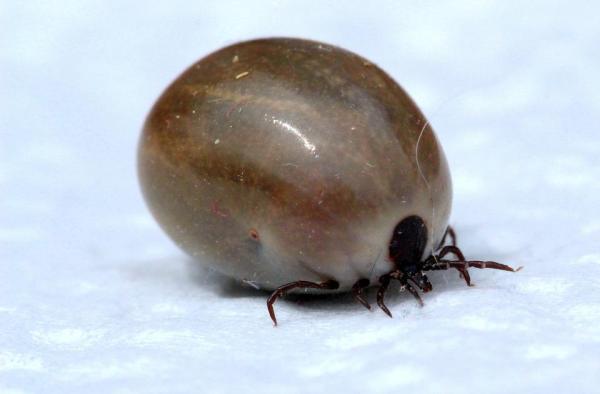
Canine babesiosis or Babesia Canisis a severe parasitic disease transmitted through bites by infected an tick. Babesiosis can affect dogs of all breeds and ages. However, it is more common in dogs that have not received adequate preventive medicine. When not treated quickly, babesiosis in dogs can cause irreversible damage to your dogs health, even resulting in death.
Due to the growth of the world’s tick population, babesiosis in dogs is becoming increasingly more common. This increase reaffirms the need to adopt effective prevention measures when it comes to parasite infections in dogs. In this AnimalWised article, we will be telling you everything you need to know about canine babesiosis and its symptoms, as well as appropriate forms of treatment and prevention.
Babesiosis in dogs: causes
But, what is babesiosis in dogs? Canine babesiosis targets mainly red blood cells and is caused by hematozoa, a subclass of parasite of the genus babesia. Babesia Canis and Babesia Gibsoni are the two identified babesia species known to cause this infection in dogs.[1]
Babesia Canis and Babesia Gibsoni are intracellular hematozoas of an indirect cycle. That means that these microorganisms cannot develop their larvae in an external environment, so they need an intermediate host in order to to reproduce, ie: the tick. In general, they are found in tick organisms (most common in the subspecies Rhipicefalus sanguineus) concentrated in their salivary glands, intestines or ovaries.
When an infected tick "bites" a dog, it opens the gateway for Babesia to spread to the canine organism. The tick acts as a vector that harbors and transports the hematozoa that causes canine babesiosis. Although tick bites are the main form of transmission of this disease, some animals can also be infected after receiving blood transfusions from other contaminated animals.
If the babesia manages to reach the bloodstream, it rapidly reproduces. This, in turn, affects the red blood cells and their macrophages.The hematozoa then attaches to the lung and liver tissues, where it can cause irreversible damage and even sometime death[2].
For more, we recommend reading our article where we answer the question, ‘‘Can a dog die from ticks?’’

Babesiosis in dogs: symptoms
After being bitten by an infected tick, a dog will experience an incubation period that usually lasts between 2 and 4 weeks. However, the symptoms may only become noticeable up to 2 months after the bite.
In general, the first symptoms of canine babesiosis are not very obvious or specific. These symptoms can appear as fever, tiredness and loss of appetite. In the 24 hours after the development of these first symptoms, most dogs experience a sudden generalized decline in health.
There are three different cases of canine babesiosis:
- Hyper-acute
- Acute
- Chronic
Keep reading to find out about their individual symptoms.

Acute babesiosis in dogs: symptoms
Acute canine babesiosis is the most frequent clinical parasitic disease in dogs, where rupture or destruction of red blood cells takes place (hemolytic anemia). Symptoms of acute babesiosis in dogs include:
- Anemia
- Fever
- Inflammation of the lymph nodes (increase in size)
- Spleen enlargement
- Jaundice may also appear (the mucous membranes take on a yellow coloration due to liver damage)
- Presence of blood in the urine (hematuria).
Hyper-acute babesiosis in dogs: symptoms
This is the most worrying clinical case of babesiosis in dogs, as it has a high lethality rate. The severity and rapidity of the symptoms makes the prognosis unfavorable for most dogs which are infected.
The hyper-acute phase is usually diagnosed in dogs with a severe infestation of ticks or immunodeficient animals (especially puppies). Symptoms of hyper-acute babesiosis in dogs include:
- Shock accompanied by hypothermia
- Poor tissue oxygenation (tissue hyphexis)
- Lesions in the vascular network and in various tissues of the body (mainly lungs and liver)
Chronic babesiosis in dogs: symptoms
Chronic babesiosis in dogs is the less common clinical case and may present itself as asymptomatic. That is to say: there are dogs that are carriers of Babesia who do not present symptoms.
Symptoms of chronic babesiosis in dogs include:
- Intermittent fever
- Anemia
- Weightloss
- Vomiting and diarrhea (rare)
- Accumulation of fluid in the abdomen (ascites)
- Alterations in vision and eye problems
- Neurological damage (which can generate in-coordination and convulsions)
Babesiosis in dogs: diagnosis
If you notice that your dog has any of the mentioned symptoms, we recommend consulting your veterinarian immediately. A professional will have to perform the necessary analyzes to proceed with a diagnosis and establish appropriate treatment.
A veterinarian will most likely need to perform blood and urine tests to verify the animal's health status, check for anemia and note whether the number of platelets in your pet has been reduced. However, serology (an examination of antibodies in the blood) is usually the best way to diagnose babesiosis in dogs.

Babesiosis in dogs: treatment
If your dog has been diagnosed with canine babesiosis, specific treatment for each dog will depend on the specific case. In addition, the dog’s health status will also have to be taken into consideration. A veterinarian may recommend that a dog be hospitalized to observe their reaction to treatment.
In general, basic therapy for parasite infections in dogs consists of drugs to eliminate the babesia from the body. Most veterinarians will choose to administer them by means of subcutaneous or intramuscular injections, enhancing the effect of the active principle in the medication. There are also treatments which include antibiotic administration, but these are usually less effective.
Dogs that suffer from severe anemia should receive blood transfusions, in addition to the required special care of their diet. It is also essential to combat ticks regularly so that the hematozoa does not re-enter the dog's organism.
Babeosis in dogs: prevention
Prevention babeosis in dogs is necessary to preserve a dog’s good health. The best way to prevent canine babeosis is to respect periodic deworming (internal and external) of dogs and use good quality products to combat ticks. In addition, don’t to visit a veterinarian every 6 months and keep up the vaccination schedule of our dogs.
For more, take a look at our article where we discuss deworming dogs: prevention and treating parasites in dogs.

Parasite infection in dogs
For more about why deworming your dog is important, take a look at our video below:

This article is purely informative. AnimalWised does not have the authority to prescribe any veterinary treatment or create a diagnosis. We invite you to take your pet to the veterinarian if they are suffering from any condition or pain.
If you want to read similar articles to Babesiosis In Dogs - Symptoms, Causes And Prevention, we recommend you visit our Parasitic diseases category.
1 Bulletin De La Societe De Pathologie Exotique, 2001.
2 https://europepmc.org/abstract/med/12910748
1 https://www.dovepress.com/canine-babesiosis-a-perspective-on-clinical-complications-biomarkers-a-peer-reviewed-fulltext-article-VMRR